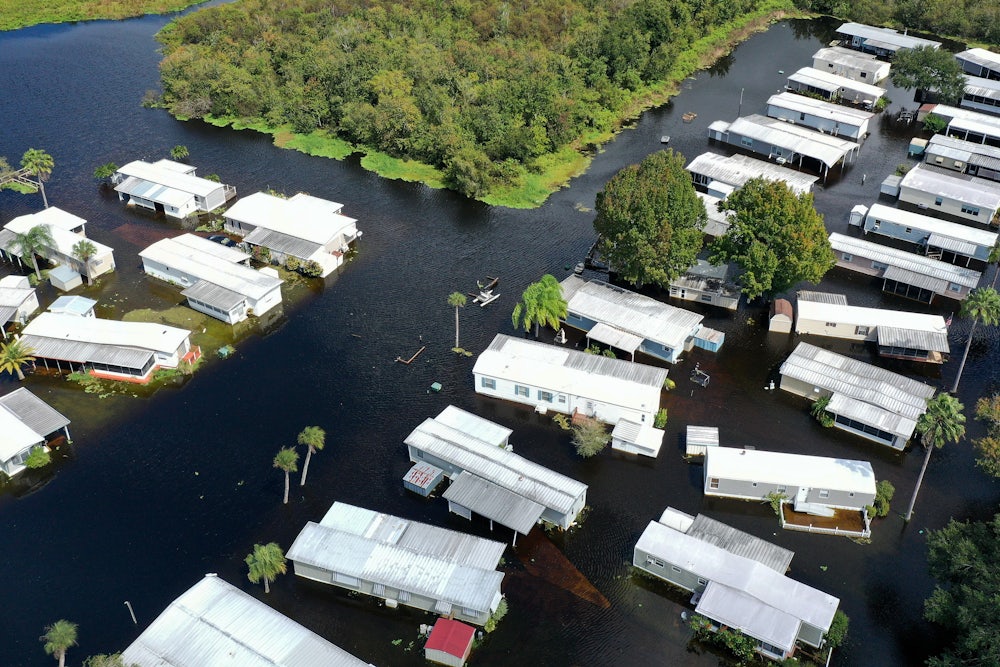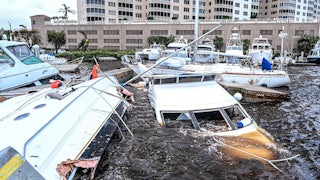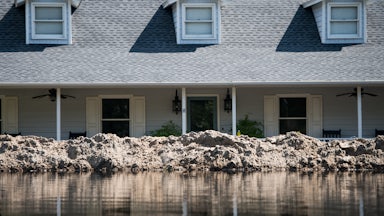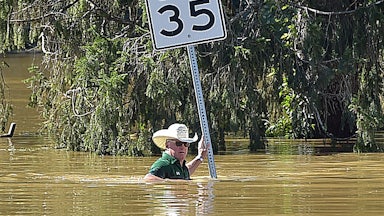The days since Hurricane Ian have seen a horrifying string of information flood in. So far, 109 people have been confirmed dead. At least 55 of those deaths occurred in Lee County, Florida, where evacuation orders were issued just 24 hours before Ian made landfall. Communications have been spotty from storm-battered jails and prisons, which in the aftermath of previous storms have been the sites of horrifying conditions and unnecessary deaths.
The sobering message here is that the worst could be yet to come. As recovery efforts lumber along and more bodies are uncovered, insurance companies and other private-sector groups could make it even more expensive to live in the already pricey Sunshine State. The damage of Hurricane Ian doesn’t stop once storms blow over. And it won’t be distributed equally.
Nina Borders works as a firefighter paramedic in Clearwater, Florida, serving the predominantly Black and working-class neighborhood of Greenwood. She’s also a volunteer organizer with the Tampa Bay Area Dream Defenders, a chapter of the Black-led organizing project formed in Florida after Trayvon Martin’s killing in 2013. In addition to work fighting mass incarceration and student debt, the group has in recent weeks participated in mutual aid efforts around the state post-Ian.
She lives about a mile from the coast and was placed under an evacuation order. When she left for her multiday shift at the station, Borders said, “I really thought I would lose my house.” Clearwater, thankfully, was largely spared the worst of the Ian’s wrath; a blowout tide sucked water out of the Bay. “It’s kind of what we all hoped for,” Borders said.
Intense winds still downed power lines and caused blackouts in Clearwater. Those winds were also enough to cause officials to shut down local 911 services, standard protocol for when winds or coastal flooding make it dangerous for first responders to navigate with limited equipment. During hurricanes like Ian, 911 calls are rerouted via emergency operation centers—including government officials and fire and police departments—that coordinate to pool and distribute the public safety resources under their jurisdiction. Emergency declarations unlock additional funding, equipment, and staffing.
Still, there are many ways for people to fall through the cracks. In marginalized communities and low-income neighborhoods, especially—where more people lack quality health care and preventative care options—paramedics and firefighters serve as frontline health care workers. “People think we’re going to fires. We do that, but most of the time we’re running basic health care for the community,” attending to calls for conditions like chronic obstructive pulmonary disease, cellulitis, and urinary tract infections. “When storms block access to basic roads due to flooding, frontline health care ceases to exist,” Borders says. If an area faces an evacuation order, that can mean there may not be first responders nearby. Those opting to shelter in place could go without care, in addition to facing the immediate danger from the storm itself. Yet those who shelter in place often do so because they lack the ability to evacuate.
“When you order an evacuation 24 hours before,” as happened in Lee County, “that assumes you have a vehicle and that you have the means to leave the area and the money to go somewhere else,” said Borders. People need not just money for gas but also for accommodations or a friend or family member they can stay with. That bar is too high for many. “When you talk about low-income, marginalized communities, there aren’t major buses taking people out,” Borders told me.
Whether those in a storm’s path stay or go, damage to their homes—especially at the scale caused by Ian—threatens to compound a housing crisis that has already driven many Floridians out. Half of the country’s top 10 fastest-growing housing markets are on Florida’s West Coast, which hadn’t endured a major hurricane for more than a century. Fort Meyers was the sixth-fastest-growing city in the United States between July 2020 and July 2021. Housing prices statewide have skyrocketed in recent years, along with insurance premiums, with rents growing by 30 percent in the last two years. The University of Florida’s Shimberg Center estimates that 2.24 million households in Florida that make less than $50,000 per year already spend 30 percent of their income on rent. As damages mount, real estate investors have begun snapping up properties in more elevated areas. In some cases, that means displacing working-class communities and communities of color in a phenomenon known as climate gentrification.
Flood insurance is a prerequisite for getting a federally backed mortgage on houses in flood-prone areas. Those policies could soon become either prohibitively expensive or even nonexistent as providers try to cut their losses. Under an emergency order from Florida Insurance Commissioner David Altmaier, insurers are now barred from dropping customers from their policies until November 28. Though the order offers temporary protection—and mandates that insurers retain customers for at least 90 days after they make repairs from Hurricane Ian—some fear its expiration could leave many across the state scrambling to find coverage at ballooning prices.
The state’s insurance sector was already in bad shape before Ian. Several insurers fled the state after Hurricane Andrew hit in 1992, leaving smaller firms to fill in the gaps with more expensive policies. Rates increased by 72 percent in the four years after that storm. Homeowners pay those costs directly, while renters see it passed along by landlords who may or may not be keen to make repairs in the aftermath of a storm. Ian is estimated to have caused more than $60 million in insured losses in Florida alone. More than 80 percent of Floridians don’t have any flood insurance at all and will have to foot the bill for damages caused by Ian’s water themselves or with limited federal funds. Twelve percent of Florida homeowners have no homeowners’ insurance at all.
Those confined to jails and prisons are facing even worse conditions. Mei Azzad, a volunteer community organizer with Fight Toxic Prisons, or FTP, spent the days leading up to Ian calling up prisons and jails in its path. The group works with currently and formerly incarcerated people and their loved ones and organized “phone zaps” to detention facilities and relevant government offices to demand evacuations in the days leading up to a storm. They also push jails and prisons to stockpile food, water, and medical supplies and create transparent distribution plans, and encourage them to simply release prisoners—starting with those who have medical conditions. “The best way to keep incarcerated people safe from a storm is to make sure they are not incarcerated,” Azzad says. FTP has also worked to stop new detention facilities from being built, including a proposed maximum-security federal prison in Letcher County, Kentucky, which endured catastrophic flooding this summer. After withdrawing a $500 billion plan under legal and organizing pressure in 2019, the Bureau of Prisons filed last week to resurrect the project.
FTP is also pushing for detention centers to develop clear plans for how to deal with disasters. “We’re responding to individual storms and have been successful in that in some cases, but we’re also advocating for there to be standardized systems” that don’t currently exist. But Azzad says officials she speaks with tend to be leery of sharing whatever plans might be in place. “In the past when we’ve called federal facilities, I’ve been told by people answering the phone that the feds never evacuate. I’ve also been told they can’t share that information,” Azzad told me. Even when facilities do evacuate, officials often won’t inform loved ones of incarcerated people that they’ve been moved—or tell them when asked, Azzad added.
The days after a storm hits can be even worse than the point of impact, as prisoners struggle to get clean water in sometimes sweltering conditions with shorter staffing. “We have loved ones [of incarcerated people] telling us that they’re only able to eat bread with raw cabbage,” Azzad told me the week after Hurricane Ian. In the days after Hurricane Harvey hit Texas in 2017, prisoners at the Beaumont Federal Prison reported having to drink toilet water while confined for days in flooded cells, living on merely two sandwiches a day. Eric Finley described conditions at the Moore County Correctional Facility for the Prison Journalism Project in the lead-up to Hurricane Ian. “Water has made its way inside through a roof vent, a door and a few windows,” Finley wrote. “We are surrounded by concrete but can still sense the strong winds outside. Power has flickered on and off all day, the water has been turned off and fire alarms have sounded constantly.” Prisoners there were given two bottles of drinking water and trash cans of water with which to flush toilets.
The Lee County Jail in Fort Myers was in a mandatory evacuation zone, but the Sheriff’s Office refused to relocate its residents elsewhere. In response to a story in the Miami New Times, Lee County Sheriff Carmine Marceno stated that inmates were safe after having been moved to a higher floor. Subsequent New Times reporting contradicted that claim. Inmates reported to their family members that toilets were overflowing and they had been given “cloudy brown water” to drink, with bottled water and air conditioning available only to guards and other staff. Like many places where already fragile infrastructure has been damaged by storms, Lee County remained under a boil-water advisory as of Tuesday evening. “Due to multiple water main breaks you may experience intermittent disturbances in water pressure or no water,” the county website states.
It can also just be hard to get a sense for what’s actually happening on the inside. When we spoke on Tuesday, Azzad says that phone lines at the Charlotte Correctional Institution in Punta Gorda, Florida, had been down since Ian. Calls to several other facilities in Ian’s path hadn’t gotten through, either, thanks in part to power outages.
“All the problems people in the free world encounter post-hurricane, incarcerated people face those problems to a higher, more acute degree and with less access to resources and information,” Azzad said. “The logic of incarceration is the same logic that has created the conditions of climate chaos. It’s the logic of disposability.”










